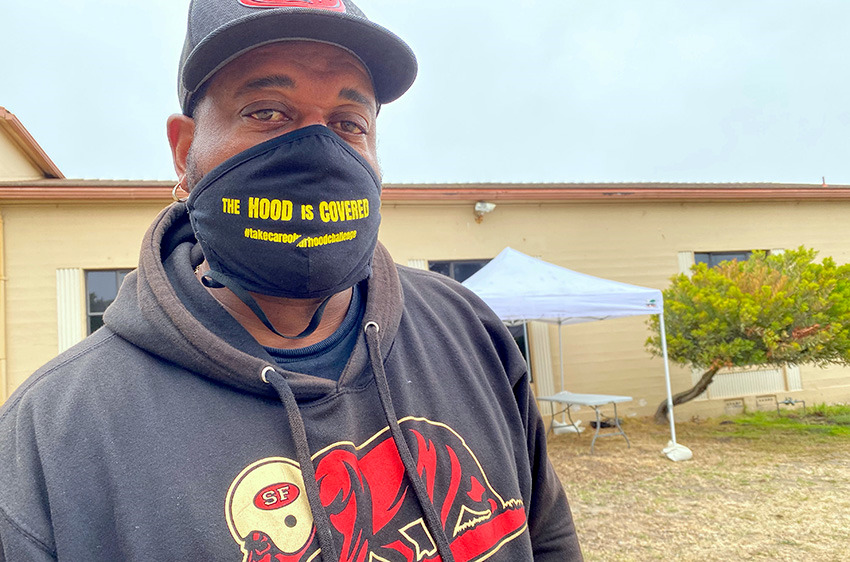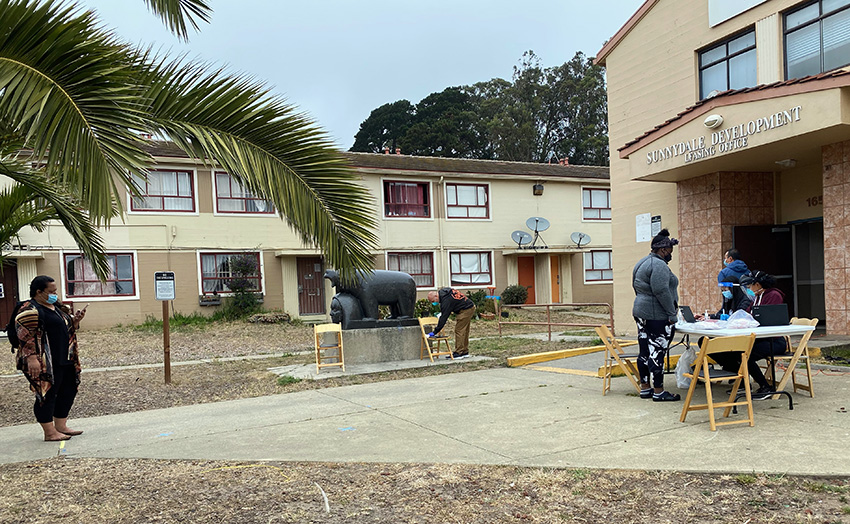Sunnydale Locals Flatten a Public Housing COVID-19 Outbreak
 Drew Jenkins at the Sunnydale testing popup. Photo by Lydia Chávez.
Drew Jenkins at the Sunnydale testing popup. Photo by Lydia Chávez.The party in Sunnydale in late June was a lively affair, with strippers and people from several families who live in a public housing project of 700-plus units in Visitacion Valley. A few days later, one of the young revelers got into trouble. After routine testing at juvenile hall, he came back positive for COVID-19.
It’s unclear who got the first call. But Drew Jenkins, a community leader who works for Mercy Housing, which operates the Sunnydale housing project, was at the top of the list. That was lucky. With some quick action on the ground, and an appeal to his community and UCSF contacts for support, Sunnydale was able to contain the virus’s spread.
The experience shows that a hyperlocal approach to contact tracing and testing can work, healthcare workers said. And it is another instance of how Bayview Hunters Point, Sunnydale, Visitacion Valley, and the Mission — communities in southeast San Francisco that together account for 31 percent of the city’s COVID cases — have had to lobby hard for testing sites.
“We had a good scare,” Jenkins said on a recent Thursday morning at a pop-up testing site at the Sunnydale Community Center. The pop-up opened in July, after the outbreak.
Without any formal training in contact tracing, Jenkins and his friend Larry Jones, a community leader who also works for Mercy Housing, figured out “who hung with who and who we could call in the family to persuade them to get tested,” Jenkins said. Getting testing, however, proved difficult.
“It wasn’t really going the way we wanted it to,” he said. “It can be frustrating when people are being denied testing. They can get the wrong message. They feel very rejected.”
“It can be frustrating when people are being denied testing. They can get the wrong message. They feel very rejected.”
 Testing on July 30 in Sunnydale. Photo by Lydia Chávez.
Testing on July 30 in Sunnydale. Photo by Lydia Chávez.So Jenkins and Jones sent SOS emails to a number of people, including Dr. Monique LeSarre, the executive director of the Rafiki Coalition, a center for health and wellness in Bayview, and Dr. Kim Rhoads, a UC San Francisco professor of epidemiology and biostatistics and the director of community engagement for the UCSF’s cancer center. Rhoads had helped orchestrate an earlier UCSF testing campaign in the neighborhood.
Rhoads and LeSarre worked together, each pressing in their own way, said LeSarre. Theo Miller, the director of SFHope, a nonprofit with the city and the San Francisco Foundation taking the lead in redeveloping Sunnydale, was also called in for help.
The community had already planned to offer public education on the coronavirus on Sunnydale’s annual Family Day celebration on June 27. With days to spare, they managed to persuade the Department of Health to bring in testing.
That day, nine of the 118 people tested turned out positive, a positivity rate of 7.6 percent.
“At first, a lot of people were very unfamiliar with the virus,” Jenkins said. Thanks to the quick response, “we were able to contain it. We got off to a good start.”
“At first, a lot of people were very unfamiliar with the virus,” Jenkins said. Thanks to the quick response, “we were able to contain it. We got off to a good start.”
On the following two Thursdays, July 9 and 16, only one person in 100 and then one in 77 came back positive. The results provided important validation for a flat-out community effort. What happened next, however, shows how quickly that validation can be erased.
The Sunnydale tests on July 23 went to an outside lab, instead of the city’s lab, and the results were lumped in with all of the tests sent to the lab that day. As a result, it was more difficult to update Sunnydale how it was doing – an important means of engaging local residents.“The community has to be served in the way the community works, and not the way the DPH thinks it works,” said LeSarre.
Rhoads and LeSarre envision a day when all community groups will be on the weekly calls with the Department of Public Health that began last Friday. In the event of an outbreak, testing will be sent to hotspots as well as being made available at neighborhood clinics so that anyone with symptoms can get tested quickly.
LeSarre said the communities refuse to be pitted against one another for resources and added that the Latino Task Force has already been a big help to their efforts in Sunnydale and elsewhere in the southeast. Local advocates understand the benefit of using people from the community to get things done and they want to see that value in the city’s COVID strategy. So do UCSF doctors who have worked with local groups.
“DPH is trying to function like this is normal time, and it isn’t, and that’s the problem with contact tracing, it takes forever,” said Rhoads. With people like Jenkins and Jones on the ground, “you leverage that asset to the hilt.”
Dr. Carina Marquez, who is also from UCSF and has worked closely with the Latino Task Force, agrees on the benefits of engaging locally. The Mission study, she said, would never have happened without UCSF embracing the help of the Latino Task Force.
Local public health advocates would like to see more contact tracers hired who know the communities they work in and test results that come back fast enough to stop asymptomatic carriers from spreading the virus. They want to see city health officials practice what they preach – to follow the data and the science in setting the city’s strategy.
While they’ve made progress, LeSarre said, “It has been a struggle. We’ve been very pressed, and still the resources are not coming to us as they are to other areas.”
Since the start of the pandemic, the city’s data has shown that the southeastern neighborhoods have been disproportionately affected: Bayview Hunter’s Point has 245 cases per 10,000 residents; Visitacion Valley, which includes Sunnydale, has 163 cases per 10,000, and the Mission has 164 cases per 10,000 residents. This compares to places like the Marina with 49.7 cases per 10,000; Noe Valley, 39.1 cases per 10,000; and Nob Hill 45.9 cases per 10,000.
It took an outbreak in Sunnydale to get testing there. Mission activists campaigned for months to finally get testing at the Hub on Alabama Street, and each week they have had to fight to increase the number of tests. Recently — again, with the help of UCSF – the Latino Task Force has opened Wednesday and Friday testing at the 24th Street BART Station. Demand there was so high in its first week that they ran out of tests on both days.
Late last month, Mayor London Breed announced the city will open a more permanent testing site in the highly impacted southeast. As of this week, however, that site’s location has not yet been chosen, a spokesperson from the Department of Public Health wrote.
Written by Lydia Chavez of Mission Local

